#Dorset fossil
Explore tagged Tumblr posts
Photo

Pygaster Fossil Regular Echinoid Jurassic Dorset UK Genuine Specimen
Featured here is a genuine Pygaster fossil, a well-preserved example of a regular echinoid (sea urchin) from the Jurassic Period (approximately 201 to 145 million years ago). This specimen was sourced from the famous fossil beds of Dorset, UK, part of England's renowned Jurassic Coast.
Geology & Origin:
The Jurassic Coast of Dorset is a UNESCO World Heritage Site, known globally for its rich fossil record and accessible sedimentary layers. During the Jurassic, this area was submerged under a warm shallow sea, ideal for marine organisms such as echinoids. As these creatures died, they were quickly buried under sediment and fossilized in exceptional detail. The result is a rare and scientifically valuable fossil like this specimen of Pygaster.
Fossil Type & Species:
Type: Fossil Echinoid (Regular Sea Urchin)
Genus: Pygaster
Preservation: Very good, with detailed test and surface features
Features:
100% genuine, natural fossil specimen
Includes a Certificate of Authenticity
Hand-selected for display quality and geological importance
The exact fossil pictured is the one you will receive
Scale cube = 1cm: See photo for accurate sizing
Why Buy From Us? We provide only authentic, professionally prepared fossils that are carefully sourced and selected. Every specimen is accompanied by a Certificate of Authenticity, giving you complete peace of mind.
Ideal for collectors, educators, natural history enthusiasts, or as a unique decor piece that brings Earth’s ancient marine world into your space.
#Pygaster#Fossil Echinoid#Jurassic Fossil#Dorset Fossil#UK Fossil#Regular Echinoid Fossil#Sea Urchin Fossil#Authentic Fossil Echinoid#Fossil from England#Marine Fossil Jurassic#Fossil with Certificate#Natural History Fossil#Fossil Collector Specimen
0 notes
Text
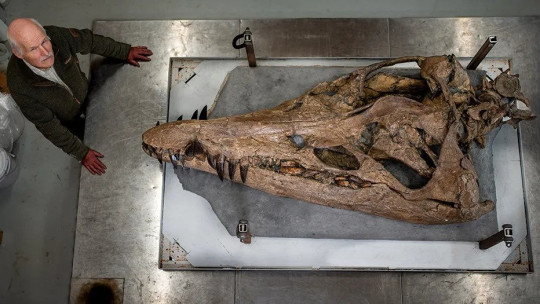
Gigantic Skull of Prehistoric Sea Monster Found on England’s ‘Jurassic Coast’
The remarkably well-preserved skull of a gigantic pliosaur, a prehistoric sea monster, has been discovered on a beach in the county of Dorset in southern England, and it could reveal secrets about these awe-inspiring creatures.
Pliosaurs dominated the oceans at a time when dinosaurs roamed the land. The unearthed fossil is about 150 million years old, almost 3 million years younger than any other pliosaur find. Researchers are analyzing the specimen to determine whether it could even be a species new to science.
Originally spotted in spring 2022, the fossil, along with its complicated excavation and ongoing scientific investigation, are now detailed in the upcoming BBC documentary “Attenborough and the Jurassic Sea Monster,” presented by legendary naturalist Sir David Attenborough, that will air February 14 on PBS.

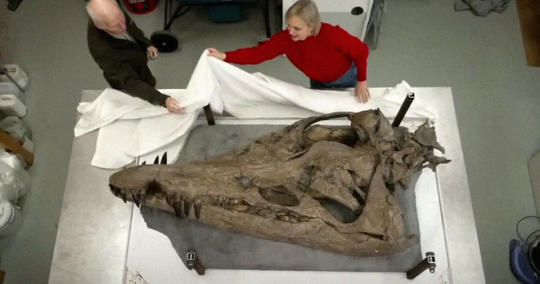
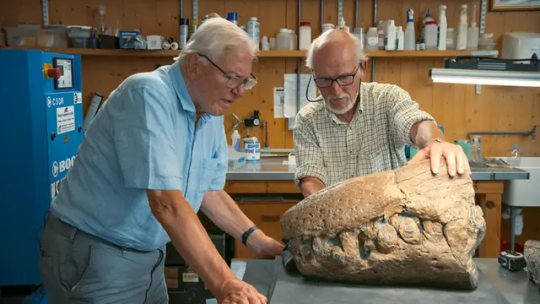
Such was the enormous size of the carnivorous marine reptile that the skull, excavated from a cliff along Dorset’s “Jurassic Coast,” is almost 2 meters (6.6 feet) long. In its fossilized form, the specimen weighs over half a metric ton. Pliosaurs species could grow to 15 meters (50 feet) in length, according to Encyclopaedia Britannica.
The fossil was buried deep in the cliff, about 11 meters (36 feet) above the ground and 15 meters (49 feet) down the cliff, local paleontologist Steve Etches, who helped uncover it, said in a video call.
Extracting it proved a perilous task, one fraught with danger as a crew raced against the clock during a window of good weather before summer storms closed in and the cliff eroded, possibly taking the rare and significant fossil with it.
Etches first learned of the fossil’s existence when his friend Philip Jacobs called him after coming across the pliosaur’s snout on the beach. Right from the start, they were “quite excited, because its jaws closed together which indicates (the fossil) is complete,” Etches said.
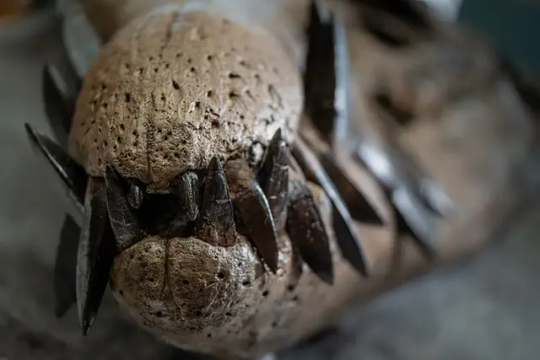
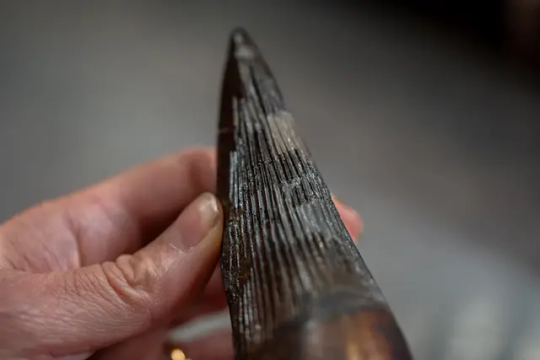
After using drones to map the cliff and identify the rest of the pliosaur’s precise position, Etches and his team embarked on a three-week operation, chiseling into the cliff while suspended in midair.
“It’s a miracle we got it out,” he said, “because we had one last day to get this thing out, which we did at 9:30 p.m.”
Etches took on the task of painstakingly restoring the skull. There was a time he found “very disillusioning” as the mud, and bone, had cracked, but “over the following days and weeks, it was a case of …, like a jigsaw, putting it all back. It took a long time but every bit of bone we got back in.”
It’s a “freak of nature” that this fossil remains in such good condition, Etches added. “It died in the right environment, there was a lot of sedimentation … so when it died and went down to the seafloor, it got buried quite quickly.”
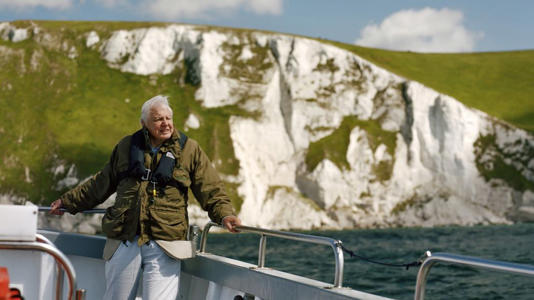
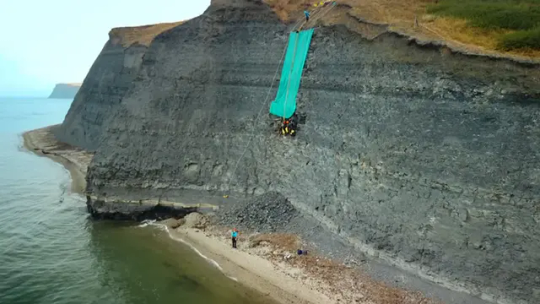
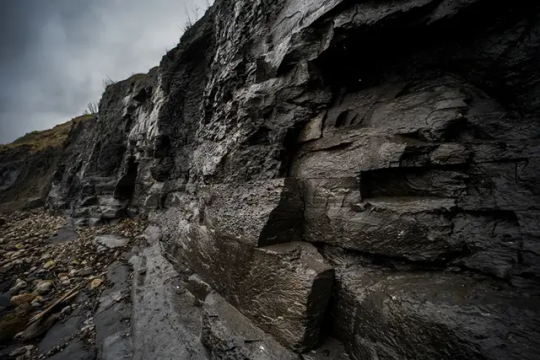
Fearsome top predator of the seas
The nearly intact fossil illuminates the characteristics that made the pliosaur a truly fearsome predator, hunting prey such as the dolphinlike ichthyosaur. The apex predator with huge razor-sharp teeth used a variety of senses, including sensory pits still visible on its skull that may have allowed it to detect changes in water pressure, according to the documentary.
The pliosaur had a bite twice as powerful as a saltwater crocodile, which has the world’s most powerful jaws today, according to Emily Rayfield, a professor of paleobiology at the University of Bristol in the United Kingdom who appeared in the documentary. The prehistoric marine predator would have been able to cut into a car, she said.
Andre Rowe, a postdoctoral research associate of paleobiology at the University of Bristol, added that “the animal would have been so massive that I think it would have been able to prey effectively on anything that was unfortunate enough to be in its space.”
By Issy Ronald.
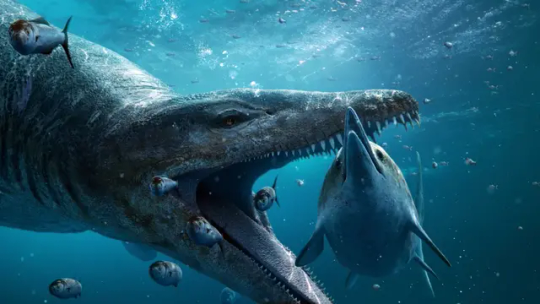
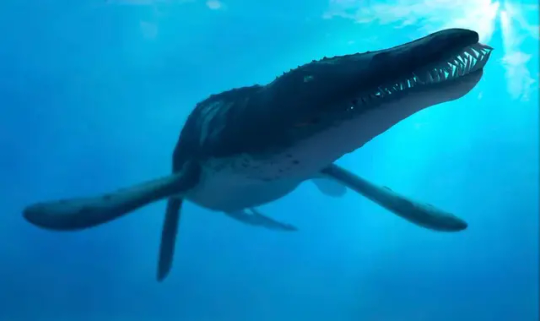
#Gigantic Skull of Prehistoric Sea Monster Found on England’s ‘Jurassic Coast’#Dorset England#pliosaur#jurassic#fossil#prehistoric#dinosaur#paleobiology#palaeontologists#archaeology#archeolgst#history#history news#ancient history#Sir David Attenborough#nature#naturalist
2K notes
·
View notes
Text




Lyme Regis, Dorset, England
19 notes
·
View notes
Text





Fossil hunting
0 notes
Text
An Information About Dinosaur Fossils Dorset Pliosaur

Dorset, a county located on the southern coast of England, boasts a variety of beautiful landscapes and a tremendous amount of history in the form of dinosaur fossils. Of these, the pliosaur fossils are truly remarkable: these were marine reptiles that roamed Earth during the Jurassic era, offering an appealing glance at life on Earth in those times. Through this post, you will get information about dinosaur fossils of Dorset pliosaur. Read more: https://fossilageminerals.wordpress.com/2024/10/01/an-information-about-dinosaur-fossils-dorset-pliosaur/
0 notes
Text


Below the cut is a template email to send to Edinburgh Pride regarding sponsorship from Aegon, who have investments linked to the genocide in Palestine. Please feel free to use this text or edit it and make it your own and send it to [email protected]
Dear Edinburgh Pride,
As a queer person living in Edinburgh, I was deeply saddened to learn that the march partner for Edinburgh Pride 2024 is Aegon.
In December 2023 the ‘Don’t Buy Into Occupation Coalition’ published a report that showed Aegon have US$564million invested via shares and bonds in companies operating in illegal settlements in Occupied Palestinian Territories. Source: https://dontbuyintooccupation.org/wp-content/uploads/2023/12/2023_DBIO-III-Report_11-December-2023.pdf
We are watching a live-streamed genocide every day - over 36,000 people in Palestine have been murdered by Israeli forces, including at least 15,000 children. The brutality of these atrocities are unthinkable, with evidence of torture and targeting of hospitals, ambulances and refugee camps.
We all have a responsibility to do what we can to end this genocide. As queer people, we are part of a rich history of resisting oppression and dehumanisation - of both ourselves and those we stand in solidarity with. Pride started as a protest against homophobia, transphobia and police violence. It is an important moment to come together as a community to celebrate queer joy and resilience.
But how can we celebrate using profits stained with the blood of our siblings in Palestine?
Aegon has $564million invested in companies that have been listed by the UN as “raising human rights concerns” for their operations in illegal settlements in Occupied Palestinian Territories, In 1948, 750,000 Palestinian people were displaced from their homes and lands and since then, Israeli settlements have been used to spread this process of colonisation.
In addition to this figure, Aegon also has major investments in Eaton Corp Plc., who supply parts for helicopters and fighter jets to the Israeli military and have recently been the target of major protests at their factory in Dorset. They also invest in Amazon, who support the Israeli military with surveillance technology used against Palestians.
Israel has long used ‘pinkwashing’ as a tactic to justify the brutal repression of Palestinians, using queer people to legitimise this horrific violence. We refuse to allow this to be done in our name.
The tide is turning on companies like Aegon that profit from investments in the companies complicit in genocide. Recently, both Hay and Edinburgh Book Festival have dropped Baillie Gifford as a sponsor after over 800 authors called on them to divest from companies involved in Israel and the fossil fuel industry.
I ask that Edinburgh Pride:
Calls on Aegon to commit to divest from companies involved in supplying technology to Israel and operating in illegal settlements.
Drop Aegon as a sponsor until they are able to show evidence of divestment.
Publicly call for a ceasefire and a free Palestine.
There is no pride in genocide.
I look forward to hearing your response.
XX
Sources:
Investments in companies operating in illegal settlements https://dontbuyintooccupation.org/wp-content/uploads/2023/12/2023_DBIO-III-Report_11-December-2023.pdf
Investments in Eaton https://extranet.secure.aegon.co.uk/static/sxhub/pdf/client-pen-distribution.pdf
Investments in Amazon https://www.aegon.co.uk/content/dam/auk/assets/publication/fund-factsheet/standard_bkj9zs0.pdf
Israel’s pinkwashing: https://bdsmovement.net/pinkwashing
War on Gaza statistics: https://www.aljazeera.com/news/longform/2023/10/9/israel-hamas-war-in-maps-and-charts-live-tracker
Edinburgh book festival ends Baillie Gifford sponsorship: https://www.bbc.co.uk/news/articles/cm553zrr3e4o
6K notes
·
View notes
Text

Rare beautiful golden pyrite ammonite fossils from the world famous Jurassic Coast beach of Charmouth, Dorset UK.
Photo : 📷 Fms.fossils.
Dr Fiann Smithwick
612 notes
·
View notes
Text

Fossilized fish bones of a Chondrosteus acipenseroides from the Charmouth Mudstone Formation in Church Cliff Bay, Lyme Regis, Dorset, England. This Lower Jurassic aged acipenseriform is a distant relative of today's sturgeon and paddlefish and one of the earliest known taxa of this clade. This specimen was acid prepped out a beach nodule.
#fish#fossils#paleontology#palaeontology#paleo#palaeo#chondrosteus#acipenseriformes#chondrosteidae#sturgeon#paddlefish#jurassic#mesozoic#prehistoric#science#paleoblr#コンドロステウス#コンドロステウス科#チョウザメ目#化石#古生物学
94 notes
·
View notes
Text

3" Jurassic Ammonite (Asteroceras) Fossil - Dorset, England
#fav#ammonite#ammonoid#shell fossil#fossil#fossils#png#transparent#prehistoric#paleoblr#paleontology#ebay
26 notes
·
View notes
Text
Dornraptor normani Baron, 2024 (new genus and species)

(Hindlimb bones of Dornraptor normani, from Baron, 2024)
Meaning of name: Dornraptor = Dornwaraceaster [Anglo-Saxon name for the region roughly corresponding to what is now Dorset] thief [in Latin]; normani = for David B. Norman [British paleontologist]
Age: Early Jurassic (Hettangian–Sinemurian)
Where found: Blue Lias Formation, Dorset, UK
How much is known: A partial hindlimb and a partial femur (thigh bone).
Notes: Fossils of Dornraptor were originally identified in 1859 as specimens of the armored plant-eating dinosaur Scelidosaurus. Later authors thought that they more likely belonged to theropods, but left them unnamed. A new study of these specimens considers them distinct enough to be given a new genus and species. Based on phylogenetic analyses, Dornraptor was probably an early member of Averostra, the group of theropods that unites ceratosaurs and the stiff-tailed tetanurans.
Reference: Baron, M.G. 2024. A new name for old bones: a reassessment of Early Jurassic theropod remains from Dorset, England. Palaeontologia Electronica 27: 25. doi: 10.26879/1346
54 notes
·
View notes
Photo

Cenoceras Nautilus Fossil – Polished & Sectioned – Jurassic Inferior Oolite, Burton Bradstock Dorset UK – Authentic British Fossil with Certificate
This listing features a beautifully sectioned and polished Cenoceras Nautilus fossil, discovered on the world-renowned Jurassic Coast at Burton Bradstock, Dorset, UK. Dating to the Jurassic Period and preserved in the Inferior Oolite Formation, this specimen is a stunning example of ancient marine life that thrived over 170 million years ago.
Cenoceras is a genus of extinct nautiloids—an ancient group of cephalopods that includes modern nautiluses and are closely related to squid and octopuses. These marine creatures had coiled, chambered shells that allowed them to control buoyancy as they moved through the oceans. Unlike ammonites, Cenoceras featured smooth, rounded shells with less complex suture lines, giving them a more elegant appearance.
This specimen has been carefully sliced and polished, revealing the internal chamber structures of the shell. These chambers, once filled with gas or fluid, helped the animal maintain neutral buoyancy. The intricate patterns and natural mineralisation within the fossil create a striking visual appeal, making it a superb collector's item or unique decorative piece.
Your specimen was discovered by our own team members Alister and Alison on 17 January 2025 and has been meticulously cleaned, prepped, and treated by Alison for quality and preservation.
Item Details:
Name: Cenoceras Nautilus Fossil (Polished & Sectioned)
Genus: Cenoceras
Type: Nautiloid Cephalopod
Age: Jurassic Period
Geological Formation: Inferior Oolite
Location Found: Burton Bradstock, Dorset, UK
Scale Reference: Scale cube = 1cm (please see photo for full sizing)
Certificate of Authenticity: Included
ACTUAL AS SEEN: The image shows the exact specimen you will receive. Every fossil in our collection is hand-selected and professionally photographed for full transparency.
Please Note:
Some fossils may be gently propped for photography.
Colour may vary slightly due to lighting and device displays.
Measurements are approximate due to natural fossil shapes.
Once this item is sold, the listing will be updated with a new, carefully selected specimen.
100% Genuine Fossil – Professionally Selected – Certificate of Authenticity Included
#Cenoceras fossil#Nautilus fossil#Jurassic coast fossil#sectioned nautiloid#Inferior Oolite fossil#polished fossil#Burton Bradstock fossil#Dorset fossil#Jurassic nautilus UK#nautiloid ammonite fossil#authentic British fossil#Jurassic marine fossil#UK fossil collector specimen
0 notes
Text

A landslide on a Dorset beach has attracted dozens of fossil hunters in search of relics.
Some 200 enthusiasts combed the beach in the village of Charmouth, on the Jurassic Coast, collecting scores of ammonite fossils.
The majority are said to have picked up ammonites, extinct sea molluscs prized for their intricate spiral shells, which measure from 2cm to 2ft and were washed out of the mud and shale by the sea.
Very cool, if you like such things. I know good examples sell to collectors for a tidy price.

13 notes
·
View notes
Text

Mary Anning (21 May 1799 – 9 March 1847) was an English fossil collector, dealer, and palaeontologist. She became known internationally for her discoveries in Jurassic marine fossil beds in the cliffs along the English Channel at Lyme Regis in the county of Dorset, Southwest England. Anning's findings contributed to changes in scientific thinking about prehistoric life and the history of the Earth.
Anning searched for fossils in the area's Blue Lias and Charmouth Mudstone cliffs, particularly during the winter months when landslides exposed new fossils that had to be collected quickly before they were lost to the sea. Her discoveries included the first correctly identified ichthyosaur skeleton when she was twelve years old; the first two nearly complete plesiosaur skeletons; the first pterosaur skeleton located outside Germany; and fish fossils. Her observations played a key role in the discovery that coprolites, known as bezoar stones at the time, were fossilised faeces, and she also discovered that belemnite fossils contained fossilised ink sacs like those of modern cephalopods.
Anning struggled financially for much of her life. As a woman, she was not eligible to join the Geological Society of London, and she did not always receive full credit for her scientific contributions. However, her friend, geologist Henry De la Beche, who painted Duria Antiquior, the first widely circulated pictorial representation of a scene from prehistoric life derived from fossil reconstructions, based it largely on fossils Anning had found and sold prints of it for her benefit.
Anning became well known in geological circles in Britain, Europe, and America, and was consulted on issues of anatomy as well as fossil collecting. The only scientific writing of hers published in her lifetime appeared in the Magazine of Natural History in 1839, an extract from a letter that Anning had written to the magazine's editor questioning one of its claims. After her death in 1847, Anning's unusual life story attracted increasing interest.
9 notes
·
View notes
Text

Breaking News-Last year the 2-meter-long skull of a huge 10 or 12-meter-long pliosaur that lived about 150 million years ago (the creature hasn’t been formally described yet) and had a bite-force of approximately 33,000 newtons was painstakingly unearthed from the face of a cliff in the fossil-rich Jurassic Coast of Dorset, England, and it has now become the subject of a recent David Attenborough documentary that was released just a few days ago. But sad thing is, the original amateur discoverer of the fossil Philip Jacob has not been given credit for this single fascinating find, and now there’s a petition to name the Pliosaur after him.
Let justice be done to Philip Jacobs!
Here is what the living animal would look like when it is compared in size with a human time-traveler.
49 notes
·
View notes
Text
Etheldred Benett was born on 22 July 1775 at Pyt House, Tisbury, Wiltshire. By at least 1809, Benett had begun to acquire a significant collection of fossils. Her independent wealth (she never married) meant that she was able to collect high quality specimens from the many working quarries in the area, as well as from her holidays to the Dorset coast. Such was the importance of her collection that it became the first port of call for geologists studying the Wiltshire area. She also sent duplicate specimens to museums all over the country (including the Geological Society) and published books on her collection. [X]

3 notes
·
View notes
Text
god, the idea of me sharing things about my writing still makes me uncomfortable, but here's some extra background stuff about Alicent and Rhaenyra's trip to the Natural History Museum in London in chapter 3 of the Hogwarts AU:

I was actually choosing between two museums for the beginning of this chapter: Natural History Museum and the Old Operating Theatre. Obviously, NHM has dinosaurs, so it won out in the end. Plus it looks like Hogwarts on the inside, so.
And here's the Old Operating Theatre Museum that didn't make the cut. (I would've made this at least a little bit magical in the AU. Like maybe there's a secret attic for Wizarding medicine or something, you know. Or perhaps it's got cases full of St. Mungo's surgical supplies on display for young wizards and witches to look at.)


I still think it could be quite fun to put two witches in a museum with all those herbs and surgical equipments, especially with Alicent being so uninterested in general muggle stuff. Maybe I'll use this in a future AU or something, who knows.
Anyway, back to the bits about the museum. Alicent's original plan was to take Rhaenyra to see the T-Rex and all the dinosaur fossils, and to save you time, this is the T-Rex Alicent had in mind:

(Girlie really thought Rhaenyra would be interested in a flightless dragon with short arms. Girlie misjudged the situation.)
And here's the plesiosaur that caught Rhaenyra's eyes:

I think anyone who's been to the NHM would tell you that it's truly an impressive fossil. I think I stood in front of it for a good fifteen minutes the first time I went there, just craning my neck and staring up at the giant thing. And that was before Ammonite (2020) even came out.
Of course, the AU's set somewhere vaguely in the 2000s, so our baby gay Alicent never had the chance to google who Mary Anning was or watch Ammonite on repeat on some streaming service. But I was hoping someone who's seen Ammonite might pick up on the name Lyme Regis and kinda get that little ah, a nod to queer media moment.
Speaking of Lyme Regis, it's a wonderful little place in Dorset. I heard that you can still go there today and go fossil hunting, but I'm not exactly sure how one goes about that.
In a perfect world, Alicent would've loved going down to that coastal town with Rhaenyra, no matter how much she said she didn't want to freeze to death on the pebble beach.
Anyway, that's it for now. I'm sure you could've googled all of the stuff I just said, but I'm currently editing chapter five and want to quickly pop on here to share the two museums and give Lyme Regis a shout. Okay, bye!
#I am shit at updating these things I think#but hey I'm posting again so yay?#rhaenicent hogwarts au#alicent hightower#rhaenyra targaryen#rhaenicent#hotd#westenraskiss writes#behind the scenes
5 notes
·
View notes